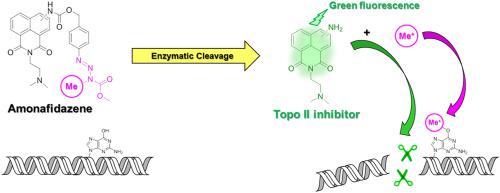European Journal of Medicinal Chemistry ( IF 6.0 ) Pub Date : 2021-08-31 , DOI: 10.1016/j.ejmech.2021.113811 Dipak Walunj 1 , Ebaston Thankarajan 1 , Chandrashekhar Prasad 1 , Helena Tuchinsky 2 , Simone Baldan 2 , Michael Y Sherman 2 , Leonid Patsenker 1 , Gary Gellerman 1

|
A DNA intercalating agent Amonafide interferes with topoisomerase 2 (Topo II) activity and prevents re-ligation of DNA strands, leading to double strand breaks (DSB). If DSB repair fails, cells stop dividing and eventually die. In a search of approaches to enhance anti-cancer activities of Topo II inhibitors, we hypothesized that introduction of additional damage in proximity to the DSB may suppress DNA repair and enhance cancer cell killing. Accordingly, chimeric molecules were created that target a DNA alkylating component to the proximity of Topo II-induced DSBs. These chimeras consist of Amonafide or its 4-amino isomer, and DNA methylating methyl triazene moiety Azene protected with a carbamate group, connected via linker. Treatment of cancer cells with the chimeric molecules leads to significantly higher number of DSBs, which were repaired slower compared to Amonafide or monomethyl triazene-treated cells. On the other hand, methyl triazene linked to non-intercalating Amonafide analogs was ineffective. Together, these data strongly support our hypothesis. In line with increased DSBs, the chimeric molecules exhibited significantly higher antiproliferative activity in cancer cell lines compared to Amonafide or monomethyl triazene constituent Azene. We utilized the fluorescent properties of chimera Amonafidazene to develop ''photo-switchable'' reporting system to monitor the prodrug activation. Using this approach, we found that the chimera accumulated and was activated at the tumor sites specifically and demonstrated significantly stronger tumor suppressing activities compared to Amonafide in a xenograft model. Therefore, targeting alkylating groups to the proximity of DSB sites may become an effective approach towards enhancing anti-cancer activities of inhibitors of topoisomerases.
中文翻译:

靶向甲基化促进 DNA 双链断裂并增强癌症抑制:DNA 嵌入/甲基化双重作用嵌合体 Amonafidazene
DNA 嵌入剂Amonafide会干扰拓扑异构酶 2 (Topo II) 的活性并阻止 DNA 链的重新连接,从而导致双链断裂 (DSB)。如果 DSB 修复失败,细胞就会停止分裂并最终死亡。在寻找增强 Topo II 抑制剂抗癌活性的方法时,我们假设在 DSB 附近引入额外的损伤可能会抑制 DNA 修复并增强癌细胞杀伤。因此,产生了将 DNA 烷基化成分靶向 Topo II 诱导的 DSB 附近的嵌合分子。这些嵌合体由Amonafide或其 4-氨基异构体和 DNA 甲基化甲基三氮烯部分Azene用氨基甲酸酯基团保护,通过接头连接。用嵌合分子处理癌细胞会导致 DSB 数量显着增加,与Amonafide或单甲基三氮烯处理的细胞相比,DSB 的修复速度较慢。另一方面,与非嵌入Amonafide类似物连接的甲基三氮烯是无效的。总之,这些数据有力地支持了我们的假设。与增加的 DSB 一致,与Amonafide或单甲基三氮烯成分Azene相比,嵌合分子在癌细胞系中表现出显着更高的抗增殖活性。我们利用嵌合氨氮萘的荧光特性开发“光可切换”报告系统来监测前药活化。使用这种方法,我们发现嵌合体在肿瘤部位积累并被特异性激活,并且在异种移植模型中与Amonafide相比,表现出显着更强的肿瘤抑制活性。因此,将烷基化基团靶向 DSB 位点附近可能成为增强拓扑异构酶抑制剂抗癌活性的有效方法。











































 京公网安备 11010802027423号
京公网安备 11010802027423号